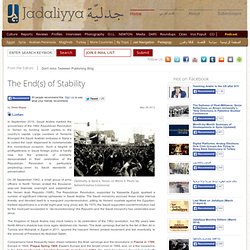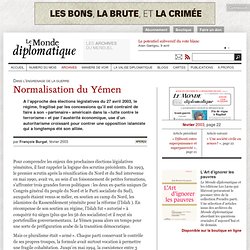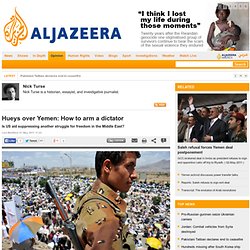

The Yemen Revolution: the Way Forward - Past Events 2012 - Events - Middle East Centre. The End(s) of Stability. In September 2010, Saudi Arabia marked the anniversary of the 1962 Republican Revolution in Yemen by funding lavish parties in the country’s capital.

Large numbers of Yemenis thronged the Saudi Arabian embassy in Sana’a to collect the cash dispensed to commemorate this momentous occasion.
How the north-south relationship in Yemen is changing. This piece was contributed by Bilal Ahmed, a student and activist completing his senior year at Rutgers University who has spent time in Yemen.

This piece was primarily written during his stay in Tahrir Square, Egypt. As always with guest contributors, their opinions are their own. Revolutionary Junctures: Documenting the Yemeni Uprising on Film. The two films presented here, “One day in the heart of the revolution ” and “Another day in the heart of the revolution,” provide snapshots of the Yemeni uprising in 2011.

People & Power - Yemen: A tale of two protests.
Yemen - reading... Into the Snake Pit: The US and Restructuring the Military in Yemen. The closest thing the US has to a "Yemen Czar" is John Brennan, President Obama's Deputy National Security Adviser, and so when he speaks on Yemen - as he did recently - it is a good idea to pay attention.

On Monday, the eve of Yemen's one-man elections, Brennan was in Sanaa, and during his time there he sat down with some journalists, and the US Embassy has since published the transcript of his roundtable. Brennan has a lot to say, and I would encourage everyone to read his full remarks, but one of the things that stood out to me was Brennan's comments on military restructuring. Obviously military restructuring is going to be one of the most important and most controversial processes of the post-Salih era in Yemen. Salih's relatives and fellow tribesmen have a stranglehold on much of the military and security apparatus in Yemen. Salih spent more than 33 years building this network, and dismantling it is going to require a great deal of patience, effort and knowledge. Breaking Point? Yemen's Southern Question. Yemen’s upheaval presents a rare opportunity to redefine its flawed and failed political compact.

At the same time, however, it has considerably raised the price of inaction. If nothing is done soon to peacefully address both national and Southern deep-seated grievances, a darker and more ominous chapter could yet be written. RECOMMENDATIONS To all Yemeni political stakeholders: 1. Agree immediately upon and implement a transition that facilitates a broadly inclusive national dialogue aimed at revising the existing political and social contract. Normalisation du Yémen, par François Burgat. Pour comprendre les enjeux des prochaines élections législatives yéménites, il faut rappeler la logique des scrutins précédents.

En 1993, le premier scrutin après la réunification du Nord et du Sud intervenue en mai 1990, avait vu, au sein d’un foisonnement de petites formations, s’affronter trois grandes forces politiques : les deux ex-partis uniques (le Congrès général du peuple du Nord et le Parti socialiste du Sud), auxquels étaient venus se mêler, en soutien au camp du Nord, les islamistes du Rassemblement yéménite pour la réforme (l’Islah ). En récompense de son soutien au régime, l’Islah fut « autorisé » à conquérir 62 sièges (plus que les 56 des socialistes) et il reçut six portefeuilles gouvernementaux.
Le Yémen passa alors un temps pour une sorte de préfiguration arabe de la transition démocratique. Mais ce pluralisme était « armé ». Chaque parti conservant le contrôle de ses propres troupes, la formule avait surtout vocation à permettre une fragile cohabitation. Yemen's Shia dilemma. In 2009, Yemeni security forces arrested four men for being Twelver Shias.

Yemen's north is dominated by Zaydis, a sect of Shias very distinct from the Twelver Shias who are found in Iraq, Iran, Lebanon, Bahrain and elsewhere. Zaydis are theologically closer to Sunni Islam than they are to mainstream Twelver Shias, and Yemen's president is himself a Zaydi. Sectarian tensions throughout the Middle East increased since the 2003 American invasion of Iraq and the civil war that followed, getting worse after the 2005 assassination of Lebanese prime minister Rafiq al Hariri who was posthumously made into a Sunni symbol, as was Iraq's Saddam Hussein following his 2006 execution.
Lebanese Hezbollah's 2006 defeat of the Israeli army and its increased influence in Lebanese politics provoked a campaign of sectarian agitation against it. Hueys over Yemen: How to arm a dictator. In recent weeks, Yemeni protesters calling for an immediate end to the 32-year reign of US-backed president Ali Abdullah Saleh have been met with increasing violence at the hands of state security forces.

A recent pledge by Saleh to step down, one of many that haven't met demonstrators' demands, has yet to halt the protests or violence by the troops backing his regime. During a demonstration earlier this month in the city of Taiz, protesters marching down a central street were confronted by security forces and Saleh supporters, while government helicopters flew overhead. "The thugs and the security forces fired on us with live gunfire," Mahmud al-Shaobi, one of the protesters told the New York Times. "Many people were shot. " In the days since, more demonstrators have been attacked by government forces – with the death toll now estimated to exceed 130.